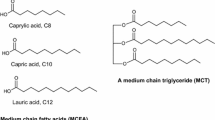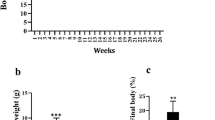Abstract
Previous research has linked hyperlipidemia with increased serum concentrations of lipid peroxidation products; however, a specific association between diet-induced oxidative stress and hyperlipidemia has not been studied. In the present study, the relationship between tissue lipid peroxidation and hyperlipidemia induced by ingestion of fish oil was examined. In Experiment 1, male Golden Syrian hamsters were fed semipurified diets composed of 1.6 wt% safflower oil plus 15.0 wt% of either butterfat (BF), safflower oil (SAFF), or high-cholesterol menhaden oil [MHO(H-CHOL)] semipurified diets for 27 d. The cholesterol contents of the diets were adjusted to 0.088%. The MHO(H-CHOL)-fed hamsters exhibited higher serum concentrations of total cholesterol, triglycerides, apolipoprotein B, and lipid peroxides when compared to the BF and SAFF diet groups. In a further study (Experiment 2), hamsters were fed for 27 d three dietary treatments: (i) MHO(H-CHOL) with no vitamin E content; (ii) a low-cholesterol menhaden oil containing high concentrations of vitamin E (2.5 mg tocopherol/g oil or dietary concentrations of 375 mg/kg) [MHO(L-CHOL)+E]; and (iii) the MHO(L-CHOL+E) with added cholesterol (595 mg/kg) [MHO(L-CHOL)+CHOL+E] to match the cholesterol content of the MHO(H-CHOL). The MHO(L-CHOL)+E and MHO(L-CHOL)+CHOL+E diet groups showed lower concentrations of serum cholesterol, triglycerides, and hepatic lipid peroxides than the MHO(H-CHOL)-treated group. Moreover, in contrast to the hypercholesterolemia caused by the MHO(H-CHOL) feeding, the MHO(L-CHOL)+E and MHO(L-CHOL)+CHOL+ E diets did not show a serum cholesterol-elevating action. This study supports the hypothesis that oxidative stress in the Syrian hamster could play a causal role in dietary-induced hyperlipidemia which can be inhibited by high vitamin E intake.
Similar content being viewed by others
Abbreviations
- ANOVA:
-
analysis of variance
- BF:
-
butterfat
- HDL:
-
high density lipoprotein
- LDL:
-
low density lipoprotein
- MHO(H-CHOL):
-
high-cholesterol menhaden oil
- MHO(L-CHOL)+E:
-
low-cholesterol menhaden oil with a high vitamin E content
- MHO(L-CHOL)+CHOL+E:
-
low-cholesterol menhaden oil with a high vitamin E content and added cholesterol
- NRC:
-
National Research Council
- PUFA:
-
polyunsaturated fatty acids
- SAFF:
-
safflower oil
- TBARS:
-
thiobarbituric acid reactive substances
- USP:
-
United States Pharmacopeia
References
Vladimirov, Y.A., Olenew, V.I., Suslove, T.B., and Chememesina, Z.P. (1980) Lipid Peroxidation in Mitochondrial Membrane,Adv Lipid Res. 17, 173–247.
Yagi, K. (1987) Lipid Peroxides and Human Disease,Chem. Phys. Lip. 45, 337–351.
Stringer, M.D., Gorog, P.G., Freeman, A., and Kakkar, V.V. (1989) Lipid Peroxides and Atherosclerosis,Br. Med. J. 298, 281–284.
Hernandez, F., Menedez, S., and Wong, R. (1995) Decrease of Blood Cholesterol and Stimulation of Antioxidative Response in Cardiopathy Patients Treated with Endogenous Ozone Therapy,Free Rad. Biol Med. 19, 115–119.
Chupukcharoen, N., Komaratat, R., and Wilalrat, P. (1985) Effects of Vitamin E Deficiency on the Distribution of Cholesterol in Plasma Cholesterol in Plasma Lipoproteins and the Activity of Cholesterol 7 α-Hydrolase in Rabbit Liver,J. Nutr. 115, 468–472.
Harris, W.S. (1989) Fish Oil and Plasma and Lipoprotein Metabolism in Humans,J. Lipid Res. 30, 785–807.
Kristenen, S.D., Roberts, K.M., Lawry, J., and Martin, J.F. (1988) The Effect of Fish Oil on Atherogenesis and Thromopoiesis in Rabbits on High Cholesterol Diet,Artery 15, 250–258.
Hayes, K.C., Pronczuk, A., Stephan, Z.F., and Lanzkron, S. (1990) Comparative Lipemias in Hamsters and Three Monkey Species Fed Fish Oil, inProceedings of the AOCS Short Course on Polyunsaturated Fatty Acids and Eicosanoids (Lands, W.E.M., ed.) pp. 334–339, American Oil Chemists' Society, Champaign.
Barber, M., Wile, D., and Trayner, I. (1988) High Prevalence of Hypertriglyceridaemia and Apolipoprotein Abnormalities in Coronary Artery Disease,Br. Heart J. 60, 397–403.
Wilt, T.J., Lofgren, R.P., Nichol, K.L., Schorer, A.E., Crespin, L., Downes, D. and Eckfeldt, J. (1989) Fish Oil Supplementation Does Not Lower Choelsterol in Men with Hypercholesterolemia,Ann. Intern. Med. 111, 900–905.
Leibowitz, B.E., Hu, M.-L., and Tappel, A.L. (1990) Lipid Peroxidation in Rat Tissue Slices: Effect of Dietary Vitamin E, Corn Oil-Lard and Menhaden Oil,Lipids 25, 125–129.
Thiery, J., and Seidel, D. (1987) Fish Oil Feeding Results in Enhancement of Cholesterol-Induced Atherosclerosis in Rabbits,Atherosclerosis 63, 53–56.
Haglund, O., Luostarinen, R., Wallin, R., Wibell, L., and Saldeen, T. (1991) The Effects of Fish Oil on Triglycerides, Cholesterol, Fibrinogen and Malondialdehyde in Humans Supplemented with Vitamin E,J. Nutr. 121, 165–169.
Lenz, P.H., Watkins, T., and Bierenbaumb, M. (1991) Effect of Dietary Menhaden, Canola and Partially Hydrogenated Soy Oil Supplemented with Vitamin E upon Plasma Lipids and Platelet Aggregation,Thromb. Res. 61, 213–224.
National Research Council (1978) Nutrient Requirements of the Hamster, inNutrient Requirements of Laboratory Animals, No. 10, 3rd rev. edn., pp. 70–79, National Academy of Sciences, Washington, D.C.
Banerjee, I., Saha, S., and Dutta, J. (1992) Comparison of the Effects of Dietary Fish Oils with Different n-3 Polyunsaturated Fatty Acid Compositions on Plasma and Liver Lipids in Rats,Lipids 27, 425–428.
Childs, M.T., King, I.B., and Knopp, R.H. (1990) Divergent Lipoprotein Responses to Fish Oils with Various Ratios of Eicosapentaenoic Acid and Docosahexaenoic Acid,Am. J. Clin. Nutr. 52, 632–639.
High, K.A., and Kubow, S. (1994) n-3 Fatty Acids Inhibit Defects and Fatty Acid Changes Caused by Phenytoin in Early Gestation in Mice,Lipids 29, 771–778.
Dahle, I.K., Hill, E.G., and Holman, R.T. (1962) The TBA Reaction and the Autoxidation of Polyunsaturated Fatty Acid Methyl Esters,Arch. Biochem. Biophys. Acta 98, 253–261.
Canadian Council on Animal Care (1984)Guide to the Care and Use of Experimental Animals, Volumes I and II, National Library of Canada, Ottawa.
Oshishi, N., Ohkawa, H., Miike, A., Tatano, T., and Yagi, K. (1985) A New Assay Method for Lipid Peroxides Using Methylene Blue Derivative,Biochem. Int. 10, 205–211.
Folch, J., Lees, M., and Sloane Stanley, G.H. (1957) A Simple Method for the Isolation and Purification of Total Lipids from Animal Tissues,J. Biol. Chem. 226, 497–503.
Kanazawa, K., Inoue, N., Ashida, H., Mizuno, M., and Natake, M. (1989) What Do Thiobarbituric Acid and Hemoglobin-Methylene Blue Tests Evaluate in the Endogenous Lipid Peroxidation of Rat Liver?,J. Clin. Biochem. Nutr. 7, 69–79.
Heuck, C.C., Nothlelfer, A., Raetzer, H., and Schlierf, G. (1977) Microdetermination of Cholesterol in Serum Lipoproteins,J. Lipid Res. 18, 259–263.
Kubow, S. (1992) Inhibition of Phenytoin Bioactivation and Teratogenicity by Dietary n-3 Fatty Acids in Mice,Lipids 27, 721–728.
Roberts, A., and Thompson, J.S. (1976) Inbred Mice and Their Hybrids as an Animal Model for the Atherosclerosis Research, inAtherosclerosis Drug Discovery (Day, C.E., ed.) pp. 313–327, Plenum, New York.
Sanders, T.A.B. (1989) Nutritional Aspects of Rancidity, inRancidity in Foods (Allen, J.C., and Hamilton, R.J., eds.) Elsevier, Amsterdam.
Meydani, S.N., Shapiro, A.C., Meydani, M., Macauley, J.B., and Blumberg, J.B. (1987) Effect of Age and Dietary Fat (fish, corn and coconut oils) on Tocopherol Status of C57BL/6Nia Mice,Lipids 22, 345–350.
Kaasgaard, S.G., Holmer, G., Hoy, C.-E., Behrens, W.A., and Beare-Rogers, J.L. (1992) Effects of Dietary Linseed Oil and Marine Oil on Lipid Peroxidation in Monkey Liverin vivo andin vitro, Lipids 27, 740–745.
Katayama, T., Momota, Y., Watanabe, Y., and Kato, N. (1991) Elevated Concentrations of α-Tocopherol, Ascorbic Acid, and Serum Lipids in Rats Fed Polychlorinated Biphenyls, Chlorobutanol, or Phenobarbital,J. Nutr. Biochem. 2, 92–96.
Willingham, A.K., Bolanos, C., Bohannan, E., and Cenedella, R.J. (1993) The Effects of High Levels of Vitamin E on the Progression of Atherosclerosis in the Watanabe Heritable Hyperlipidemic Rabbit,J. Nutr. Biochem. 4, 651–658.
Stam, H., Hulsmann, W.C., Jonkind, J.F., van der Kraaij, A.M.M., and Koster, J.F. (1989) Endothelial Lesions, Dietary Composition and Lipid Peroxidation,Eicosanoids 2, 1–14.
Nistor, A., Bulla, A., Filip, D.A. and Radu, A. (1987) The Hyperlipidemic Hamster as a Model of Experiemtnal Atherosclerosis,Atherosclerosis 68, 159–173.
Trautwain, E.A., Liang, J., and Hayes, K.C. (1993) Cholesterol Gallstone Induction in Hamsters Reflects Strain Differences in Plasma Lipoproteins and Bile Acid Profiles,Lipids 28, 305–312.
Otto, D.A., Baltzell, J.K., and Wotten, J.T. (1992) Reduction in Triacylglycerol by Fish Oil Correlates with Free Fatty Acid Levels inad libitum Fed Rats,Lipids 27, 1013–1017.
Houwelingen, R.V., Nordoy, A., van der Beek, E., Houtsmuller, U., de Metz, M., and Hornstra, G. (1987) Effect of a Moderate Fish Intake on Blood Pressure, Bleeding Time, Hematology, and Clinical Chemistry in Healthy Males,Am. J. Clin. Nutr. 46, 424–436.
Bergseth, S., Christiansen, E.N., and Bremer, J. (1986) The Effect of Feeding Fish Oils, Vegetable Oils and Clofibrate on the Ketogenesis from Long-Chain Fatty Acids in Hepatocytes,Lipids 21, 508–514.
Author information
Authors and Affiliations
About this article
Cite this article
Kubow, S., Goyette, N., Kermasha, S. et al. Vitamin E inhibits fish oil-induced hyperlipidemia and tissue lipid peroxidation in hamsters. Lipids 31, 839–847 (1996). https://doi.org/10.1007/BF02522979
Received:
Accepted:
Issue Date:
DOI: https://doi.org/10.1007/BF02522979




